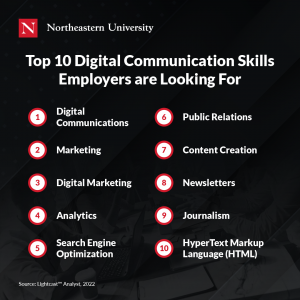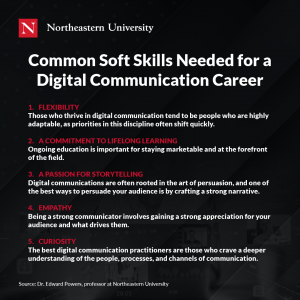Have you ever wondered who’s responsible for the targeted social media ads you see as you scroll through your feeds or the emails that let you know about events and promotions you’re actually interested in?
The professionals behind these marketing tactics work in digital communications—a field that is indispensable to most organizations today.
If you’re interested in breaking into the digital communications industry, now is a great time to explore the field; there’s a rapidly increasing demand in the job market for people with digital media skills. In fact, according to the U.S. Bureau of Labor Statistics, digital marketing demand is expected to grow by 10 percent from 2021 to 2031.
What Is Digital Communication?
Simply said, digital communication involves an organization’s online communication efforts. Most organizations today use a wide range of digital communication channels—from their website to mobile chat to blogs—to connect with current and prospective customers, employees, and other stakeholders. They need digital marketing professionals who have a keen understanding of how to leverage this convergence of technology and messaging to their advantage. Digital communications professionals are responsible for everything from creating online brand assets to building an engaged social media audience.
“Today, the options for getting a message out are much broader and quicker than they were just a few decades ago,” explains Edward Powers, professor in Northeastern’s Master of Science in Corporate and Organizational Communication and Bachelor of Science in Digital Communication and Media programs. “Digital communication professionals have to be mindful about how to put forward these new tools in the right way.”
Examples of Effective Digital Communication
Throughout the years, the number of digital communication tools continues to grow. Many aspects of everyday life are now transferred to digital formats, such as work, school, and human interactions. As a result, there’s been increasing amounts of digital content consumption. Here are some examples of effective communication being utilized through digital formats.
Spotify
One example of a company leveraging digital channels in their marketing strategy is the digital streaming service Spotify. Spotify’s Wrapped campaign—offering users a comprehensive list of their listening habits over the past year alongside national and global trends—has become an increasingly popular content offer for users to share on social media channels like Instagram and Facebook. While Spotify originally took on its social strategy of “A Year in Review” back in 2013, this campaign has evolved over time and continued to garner amazing results.

In 2015, the campaign resulted in 5 million site visitors and over 1 million social shares. To ensure users continued to see value, Spotify made further adjustments to this campaign by creating personalized playlists based on each person’s streaming habits throughout the past year. Users could click through a colorful collection of slides to see more of their favorite artists, songs, podcasts, and more. As a result, the campaign earned more than 60 million social shares from 90 million users in 2022.
In addition, Spotfiy’s Wrapped campaign has widened its demographic reach by playing off of trends and language found on trending social media platforms. For example, one of the campaign ads reads, “You always understood the assignment.” This ad copy directly plays off of a common TikTok trend that Gen Z users can relate to. Therefore, employers in many industries are seeking professionals who can navigate digital communication in this same way.
Due to the significant success of social media campaigns, digital communication has become an integral part of every business’ marketing strategy.
Airbnb
This is clear through more recent examples, such as Airbnb’s successful strategy to build their brand through their own audience’s content. Using various social media platforms to promote their user-generated content has successfully allowed them to continue growing organically. In fact, according to a government report, nearly 92 percent of consumers say they trust user-generated content more than other forms of advertising, resulting in an estimated 73 percent increased likelihood of positive comments on social media channels.

Digital communication is prevalent here since they are sharing pictures and videos directly from customers who use their services for their travels. As popularity grew, people are now more inclined to look for a place to stay through Airbnb just as much as they would be looking for a hotel.
The use of visually appealing pictures and videos to showcase the incredible sights and travel experiences others have been experiencing shows the power of digital communication. Without spending on traditional advertising methods, user-generated content is able to illustrate to potential users the benefits of using Airbnb by inspiring them to have their own unique adventures. This is particularly important to consider when looking at a government report concluding that 79 percent of consumers’ purchasing power is impacted by user-generated content.
Cadbury Worldwide Hide
Another example of innovative uses of digital communication involves Cadbury’s WorldWide Hide campaign during the pandemic. Their campaign was a direct response to the state of the world during this unprecedented time—where social contact was greatly limited unlike anyone had experienced before. The pandemic’s impact was deeply felt during Easter of that same year due to it being the first holiday where families were unable to gather together and celebrate.
This prompted Cadbury to use Google Maps to create a virtual Easter egg hunt. Through the power of digital media, they were able to create an experience that allowed our users to purchase a real Cadbury Easter Egg, hide it virtually on the map in a specific location to then notify the recipient with a personalized clue on how to find it. Once the egg was found, their loved one would be able to receive a physical egg at their home.
These examples solidify the fact that a deep understanding of digital communication can reap incredible benefits for any kind of organization. Individuals that exhibit this knowledge along with their own creativity are proven to become highly sought-after professionals for any industry.
Powers emphasizes this by saying “if you can marry together the classic training that people in the marketing communications field have relied on for decades with emerging digital technology, you will have highly marketable skills”. “The demand for digital marketing professionals is exploding across corporations, nonprofits, government agencies, and academia, and there is no letup in sight. Some of the mechanisms for communication will come and go but digital communication is pretty much ingrained in our world now.”
Top Skills for Success in Digital Communication
Employers across industries are looking for digital communication professionals with a variety of specific skill sets. According to a government report based on job posting data, the top 10 digital communication skills employers looked for from 2020 to 2022 were:
- Digital communications
- Marketing
- Digital marketing
- Analytics
- Search engine optimization (SEO)
- Public relations
- Content creation
- Newsletters
- Journalism
- HyperText Markup Language (HTML)

Along with the digital marketing skills and other areas of expertise mentioned above, there are also many “soft skills” that will serve you well in a digital communication career, including:

- Flexibility—Those who thrive in digital communication tend to be highly adaptable, as priorities in this discipline often shift quickly. “Flexibility is highly valued in these roles,” Powers explains. “Hiring managers want employees who can easily acclimate to changes.”
- A commitment to lifelong learning—Ongoing education is important for staying marketable and at the forefront of the field, Powers says. “It’s impossible to predict future changes but the most successful digital communication professionals are committed to lifelong learning to stay ahead of the rapid pace of change.”
- A passion for storytelling—Digital communications are often rooted in the art of persuasion, and one of the best ways to persuade your audience is by crafting a strong narrative.
- Empathy—Being a strong communicator involves gaining a strong appreciation for your audience and what drives them. Once you’re able to put yourself in the shoes of other people you’re trying to influence, you can establish more meaningful—and more effective —connections with them.
- Curiosity—“Being inquisitive will carry you a long way,” says Powers. “The best digital communication practitioners are those who crave a deeper understanding of the people, processes, and channels of communication.”
Common Digital Communication Career Paths
The Association of Data-Driven Marketing and Advertising (ADMA) identifies the key growth opportunities for digital communications professionals are:
Digital Strategy
According to the ADMA, using digital marketing with a clearly defined strategy is the best way to get the most return on your efforts. These roles involve the strategy behind planning, creating, and sharing content that aligns with your overall business plans. Creating this roadmap ensures all stakeholders understand their role in the marketing strategy.
Digital Marketing Technology
Technology is a driving force in any industry, therefore it’s important for marketing professionals to stay ahead of the curve. MarTech’s increased adoption of customer data platforms (CDP)—compiling customer data in a single platform, rather than relying on third parties—has led to more meaningful relationships with customers that businesses strive for. These types of roles need to understand the operational needs of their business to ensure they choose the best platform for their strategy.
Email Marketing
Despite the prominence of email marketing, data shows that this strategy is here to stay. However, these roles need to understand the importance of segmentation and personalization in their communication with users. According to Litmus, 60 percent of retail, e-commerce, and consumer goods and services companies are personalizing emails based on past purchases in 2020—versus 38 percent in 2019.
Data-driven Marketing
These roles involve testing various marketing approaches, analyzing and interpreting data, and measuring the results of marketing campaigns. Not only that, they also play a vital role in ensuring the strategy is in compliance with regulatory requirements around users’ data privacy. Individuals with an understanding of these digital tools are able to effectively measure and interpret this important information.
Search Engine Optimization (SEO)
Professionals in these roles implement, analyze, and continuously update website content and technical features to increase an organization’s search engine ranking. With the new age of voice assistance and AI, SEO professionals need to understand the conversational nature of keywords to ensure they reach the right users.
Social Media
Social media professionals are responsible for developing and executing social media marketing campaigns to influence a target audience in a variety of different digital platforms. Since there is a clear shift to more imperfect, user-generated video content in social media marketing, professionals in this field need an in-depth understanding of their audience, rather than high-level production skills. This is often achieved by acting as community managers, listening and responding to social media users in a way that is in line with the organization’s brand identity.
How To Improve Your Digital Communication Skills
Securing a lucrative career in digital communication requires specialized knowledge, a mastery of digital skills, and experience in applying those skills in the real world.
One way to gain these skills is by earning a specialized degree, such as Northeastern’s Bachelor of Science in Digital Communication and Media program, which offers a novel way for students to gain both the theoretical knowledge and the hands-on experience they need to advance in the field.
In this program, students and a professor collaborate with an employer on a short-term project that addresses a particular real-world problem their company has, enabling students to build their knowledge and skills through direct experiences outside the classroom.
In Northeastern’s BS in Digital Communication and Media program, you’ll also have the opportunity to:
- Understand and apply the principles of marketing
- Hone your writing skills to persuade and inform
- Discover how to use design as a communication tool
- Apply the fundamentals of visual communication
- Examine consumer behavior
- Analyze and interpret data
- Explore the practice of public relations
- Learn about the many facets of social media communications
- Become well versed in web and mobile development and database management
Throughout the degree program, students develop a wide range of digital competencies, including learning to apply marketing principles, conduct research, develop content, and analyze data. They then have an opportunity to put those skills to work directly as they design, implement, and manage a major communication campaign for a virtual PR firm.
Powers describes how these projects are successfully executed, even when students are scattered geographically when enrolled in an online program:
“We offer a virtual firm in which the students are the employees working on an actual digital media project for an actual client. Instead of a weekly class, we have a weekly staff meeting to plan, develop, review, and execute the campaign for the client.
In this setting, students can apply theory and put it into motion. They are part of the entire process—from discovery to strategy to execution and measurement of a communication plan. As a communications professional, you need to understand that these parts of the process are necessary for success—and need to be able to explain this to your clients you work with in the future.”
Choosing a Digital Communication Career
One of the many benefits of a digital communications degree is that it gives you the freedom to try your hand at many different aspects of the field.
“Take the opportunity to experiment with various realms within digital communication while you’re a student,” Powers advises. “You may just discover that you have an affinity for an area you hadn’t considered before.”
Digital communication is a broad area, and most professionals in the field ultimately do focus on a specific area instead of acting as a generalist. Visually-oriented students might gravitate toward a career in video or graphic design, for example, while those who are good at storytelling might prefer a career working with the press.
“Part of choosing a career in digital communication is understanding your interests, but it’s also about understanding why you’re doing the work,” Powers explains. “A good video producer can come up with creative ideas but a strong practitioner will also keep in mind the context of who their audience is and what’s in it for their target audience to watch it. That aspect of online engagement is essential.”
To learn more about Northeastern’s Digital Communication and Media program, explore our program page or speak with our team to have your questions answered.
